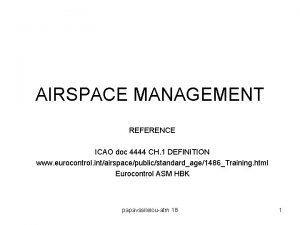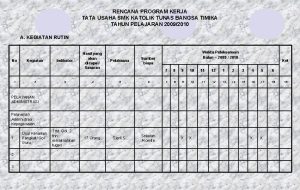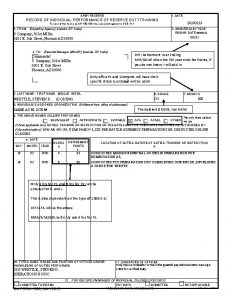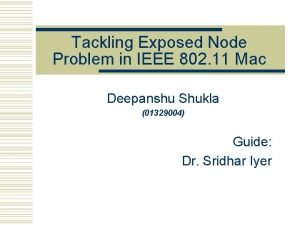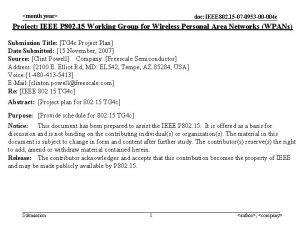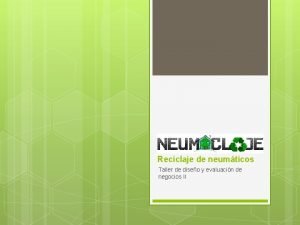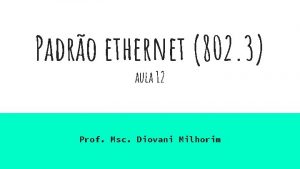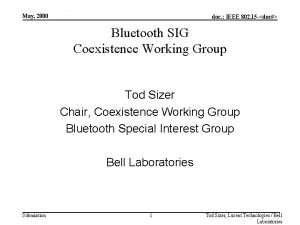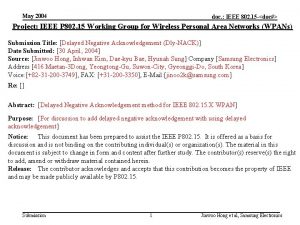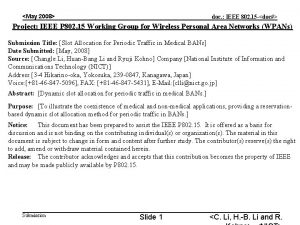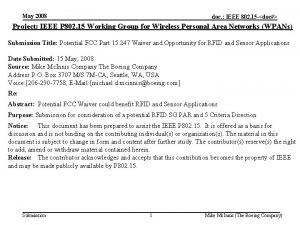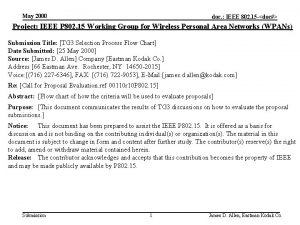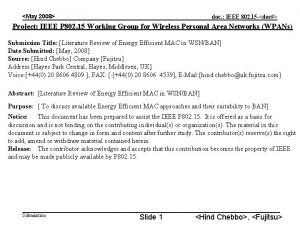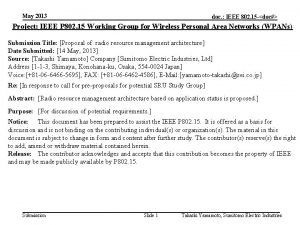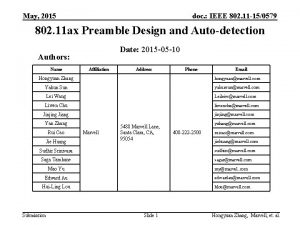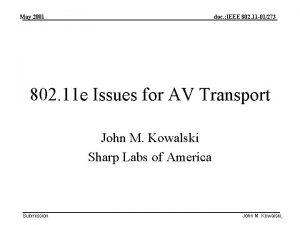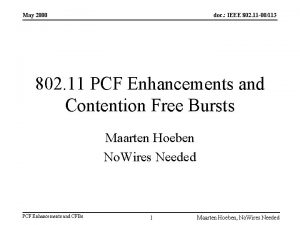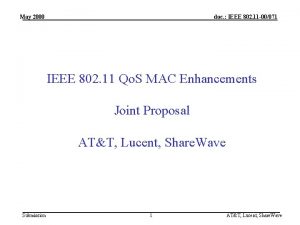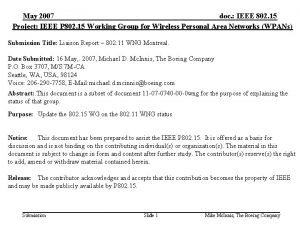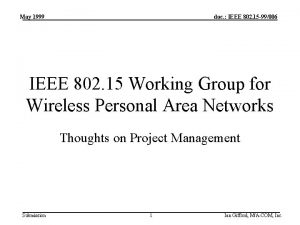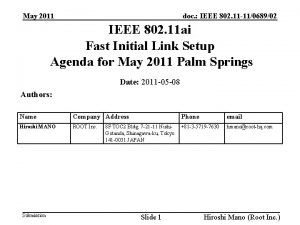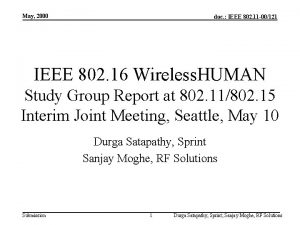May 2019 doc IEEE 802 11 190865 r


















![May 2019 doc. : IEEE 802. 11 -19/0865 r 1 References [1] [2] [3] May 2019 doc. : IEEE 802. 11 -19/0865 r 1 References [1] [2] [3]](https://slidetodoc.com/presentation_image/4077fa1d8c07cb42ff5d47c3ad3fa35f/image-19.jpg)
- Slides: 19

May 2019 doc. : IEEE 802. 11 -19/0865 r 1 LC-optimized PHY for TGbb Authors: Submission Date: 2019 -05 -13 Slide 1 Kai Lennert Bober – Fraunhofer HHI

May 2019 doc. : IEEE 802. 11 -19/0865 r 1 Abstract The submission introduces the G. 9991 PHY 1 [1] and subsequently discusses it as a potential candidate PHY for 802. 11 bb. The G. 9991 PHY 1 is currently under discussion by industrial partners in the ELIOT project for its adaptation as a LC PHY. [2] Submission Slide 2 Kai Lennert Bober – Fraunhofer HHI

May 2019 doc. : IEEE 802. 11 -19/0865 r 1 The LC-optimized PHY • Recap: TGbb to support two-pronged PHY approach: • Reuse existing 802. 11 PHYs and no silicon modification as possible lower entry barrier • Introduce LC-optimized part in PHY exploit full potential of LC • LC medium is different from RF • Electrical baseband signal via optical IM/DD • Low pass characteristic in NLOS but also LOS ([3][4]) • Much power resides in upper but attenuated part of bandwidth (-20 d. B system BW is considered) • Traditional RF-PHYs work but perform suboptimal • Baseband PHYs exist and are much more suitable! • E. g. ITU-T G. hn (G. 9960) / G. vlc (G. 9991) • Subsequently, we present the ITU-T G. 9991 baseband PHY as suiting LC-PHY Submission Slide 3 Kai Lennert Bober – Fraunhofer HHI

May 2019 doc. : IEEE 802. 11 -19/0865 r 1 G. 9991 overview • • G. 9991 aka “G. vlc” Part of G. 999 x series (optical transmission) LC = VLC + IR ITU-T Recommendation (Q 18/15 “In-premises networking”) • Started 2 H 2015 • Approval 01/04/2019 • Based largely on G. 9960/61 (aka “G. hn”) • Topologies: • P 2 P • P 2 MP • Objective: Leverage the “highly flexible OFDM engine provided by G. hn” Submission Slide 4 Kai Lennert Bober – Fraunhofer HHI

May 2019 doc. : IEEE 802. 11 -19/0865 r 1 G. 9991 overview (cont. ) Standard Ethernet Primitives Data Link Layer ITU-T G. 9991 Physical Layer ITU-T G. 9991 Application Protocol Convergence Ethernet encapsulation Logical Link Control AES 128 Security, Relaying and Retransmissions Medium Access Control Physical Coding Physical Medium Attachment Physical Medium Dependent Submission Slide 5 Master/Slave MAC TDMA+CSMA Generation of PHY frame FEC, scrambling, padding Relevant for TGbb OFDM+QAM modulation Kai Lennert Bober – Fraunhofer HHI

May 2019 doc. : IEEE 802. 11 -19/0865 r 1 G. 9991 overview (cont. ) • 2 PHY; 1 MAC • MAC: G. hn MAC + additions (FDprepared) • PHY 1: G. 9960 (DCO-OFDM) • PHY 2: ACO-OFDM • Roughly: • PHY 1: Performance-oriented • PHY 2: Less performant; For cases where dimming may be an issue • Only PHY 1 has silicon available today Submission Slide 6 Kai Lennert Bober – Fraunhofer HHI

May 2019 doc. : IEEE 802. 11 -19/0865 r 1 G. 9991 PHY -- Functional model of PHY layer TX direction: 1. Data enters the PHY layer from the MAC via the PMI in blocks of bytes called MAC protocol data units (MPDUs). 2. An incoming MPDU is mapped into a PHY frame in the PCS 3. Scrambled and encoded in the PMA 4. Modulated in the PMD and transmitted over the medium using specific OFDM modulation 5. RX direction: In the PMD, a preamble is added to facilitate synchronization and channel estimation in the receiver. Submission Slide 7 1. Frames entering from the medium via the MDI are demodulated and decoded in the PHY layer. 2. The recovered MPDUs are forwarded to the MAC layer over the PMI. 3. The recovered PHY-frame headers are processed in the PHY to extract the relevant frame parameters. Kai Lennert Bober – Fraunhofer HHI

May 2019 doc. : IEEE 802. 11 -19/0865 r 1 G. 9991 PHY framing (I) – PHY frame format • A PHY frame consists of a preamble, header, additional channel estimation (ACE) symbols (optional field, its presence is frame type dependent) and payload. • The preamble does not transport any user or management data and is intended for synchronization and initial channel estimation. • The PHY frame Header and Payload each contain an integer number of OFDM symbols • The PHY frame Header carries settings related to the payload (guard interval, bit loading, and FEC parameters) • The Payload includes one MPDU composed of one or more LPDUs (LLC Protocol Data Unit). Each LPDU carries a segment of the transmitted data, a header identifying the carried segment, and the CRC to detect “errored” LPDU for selective retransmission. • For the payload, different coding parameters and bit loading can be used in different frames, depending on the channel/noise characteristics and Qo. S requirements. Submission Slide 8 Kai Lennert Bober – Fraunhofer HHI

May 2019 doc. : IEEE 802. 11 -19/0865 r 1 G. 9991 PHY framing (II) – Header transmission Other options to provide the header with more: • Robustness • Capacity Submission Slide 9 Kai Lennert Bober – Fraunhofer HHI

May 2019 doc. : IEEE 802. 11 -19/0865 r 1 G. 9991 PHY 1 – Forward Error Correction & MIMO • FEC (Forward Error Correction): QC-LDPC-BC • Performance near Shannon theoretical limit • Three block sizes: 21 bytes (header), 120 and 540 bytes (payload) • Five Code rates: 1/2, 2/3, 5/6; 16/18 and 20/21 • Frequency-selective fading is handled through bit-loading • RF-PHYs usually rely on bit-interleaved coded modulation (BICM) • G. 9991 defines MIMO as “for further study” • However, the DCO-OFDM PHY (PHY 1) has inherited 2 x 2 MIMO capability from G. hn • Specification of technical means (precoding) exist, must be adapted Submission Slide 10 Kai Lennert Bober – Fraunhofer HHI

May 2019 doc. : IEEE 802. 11 -19/0865 r 1 G. 9991 Adaptive OFDM • Dynamic bitloading tracks SNR in each sub-carrier at each receiver independently RX spectrum RX SNR Bitloading Receiver A TX spectrum Transmitter TX Noise RX spectrum TX Receiver B Noise • The transmitter makes use of adapted modulation per subcarrier Submission Slide 11 Kai Lennert Bober – Fraunhofer HHI

May 2019 doc. : IEEE 802. 11 -19/0865 r 1 G. 9991 PHY - G. hn/G. vlc Scales OFDM Parameters to Adapt to the Medium Used for LC TGbb Submission Slide 12 Kai Lennert Bober – Fraunhofer HHI

May 2019 doc. : IEEE 802. 11 -19/0865 r 1 Summary – G. 9991 Key PHY Parameters Layer Area Value Notes Physical Layer Modulation type DCO-OFDM Configurable OFDM parameters (cyclic prefix, persubcarrier PSD, etc) Max modulation Up to 12 bits/subcarrier Each sub-carrier is modulated with a different number of bits, depending on SNR (Bitloading) FEC LDPC Multiple FEC rates (1/2, 2/3, 5/6, 16/18, 20/21) and block sizes dynamically selected Spectrum 5 -200 MHz (VLC) Individual sub-carriers can be notched to coexist with other services in same wire Subcarrier spacing 195 k. Hz (VLC) Sub-carrier spacing optimized for the expected delay spread in each medium Submission Slide 13 Kai Lennert Bober – Fraunhofer HHI

May 2019 doc. : IEEE 802. 11 -19/0865 r 1 PHY 1 Real World Performance – Industrial Scenario • MIMO arrangement and analog combining in a robotic manufacturing cell • Uplink and downlink PHY rates for multiple positions: Submission Slide 14 Position Uplink rate Downlink rate 1 89 96 2 89 96 3 100 95 4 69 95 5 150 95 6 150 95 7 150 108 8 135 108 9 95 108 10 104 90 11 103 86 12 44 94 13 138 104 Kai Lennert Bober – Fraunhofer HHI

May 2019 doc. : IEEE 802. 11 -19/0865 r 1 PHY 1 Real World Performance – Backhaul Scenario • Outdoor point-to-point arrangement • Highly directional frontend • Adaptation of the frontend for higher data rates Source: [5] Submission Slide 15 Kai Lennert Bober – Fraunhofer HHI

May 2019 doc. : IEEE 802. 11 -19/0865 r 1 Considerations on adopting G. 9991 PHY for 802. 11 bb Submission Slide 16 Kai Lennert Bober – Fraunhofer HHI

May 2019 doc. : IEEE 802. 11 -19/0865 r 1 Anticipated adaptations in G. 9991 PHY 1 • Which parts of the PHY are possibly modified to make it IEEE-compatible? • • • Support of 802. 11 legacy preamble? Adapt PPDU header to 802. 11 contents Maximum / minimum PSDU sizes? Enable higher order MIMO? … • What is additionally needed in the 802. 11 MAC? • Bitloading signalling procedure • Traditional channelization does not apply. • … • What must be modified in the PHY-SAP? • … Submission Slide 17 Kai Lennert Bober – Fraunhofer HHI

May 2019 doc. : IEEE 802. 11 -19/0865 r 1 Straw Poll Are you interested in further presentations discussing the potential suitability of the G. 9991 PHY for 802. 11 bb? Y / N / A: Submission 6 / 0 / 5 Slide 18 Kai Lennert Bober – Fraunhofer HHI
![May 2019 doc IEEE 802 11 190865 r 1 References 1 2 3 May 2019 doc. : IEEE 802. 11 -19/0865 r 1 References [1] [2] [3]](https://slidetodoc.com/presentation_image/4077fa1d8c07cb42ff5d47c3ad3fa35f/image-19.jpg)
May 2019 doc. : IEEE 802. 11 -19/0865 r 1 References [1] [2] [3] [4] [5] Submission ITU-T G. 9991 - Not yet published. Refer to G. 9960 instead for most details regarding the PHY: https: //www. itu. int/rec/T-REC-G. 9960 https: //www. photonics 21. org/ppp-projects/workgroup-4/Eliot. php Shokoufeh Mardani et. al. : Efficiency of Power Loading Strategies for Visible Light Communication Pablo Wilke Berenguer et. al. : The benefit of frequency-selective rate adaptation for optical wireless communications Dominic Schulz: Optical Wireless Communication for Fixed Access Applications – Ph. D Thesis Slide 19 Kai Lennert Bober – Fraunhofer HHI
 Bridges from 802.x to 802.y
Bridges from 802.x to 802.y Bridges from 802.x to 802.y
Bridges from 802.x to 802.y Ieee 802 3 compliance
Ieee 802 3 compliance Ieee802.22
Ieee802.22 Arquitetura ieee 802
Arquitetura ieee 802 Modelo ieee 802
Modelo ieee 802 Ieee 802 standard
Ieee 802 standard Ieee 802 bluetooth
Ieee 802 bluetooth 802 ieee
802 ieee Ieee 802
Ieee 802 Ieee 802 family
Ieee 802 family Doc 4444 icao 2019
Doc 4444 icao 2019 Program kerja tata usaha smk
Program kerja tata usaha smk Ib grades to percentage
Ib grades to percentage Da form 1380 example
Da form 1380 example Hci patterns may or may not include code for implementation
Hci patterns may or may not include code for implementation Exposed node problem
Exposed node problem 802 15
802 15 507-802-380
507-802-380 802 3
802 3











